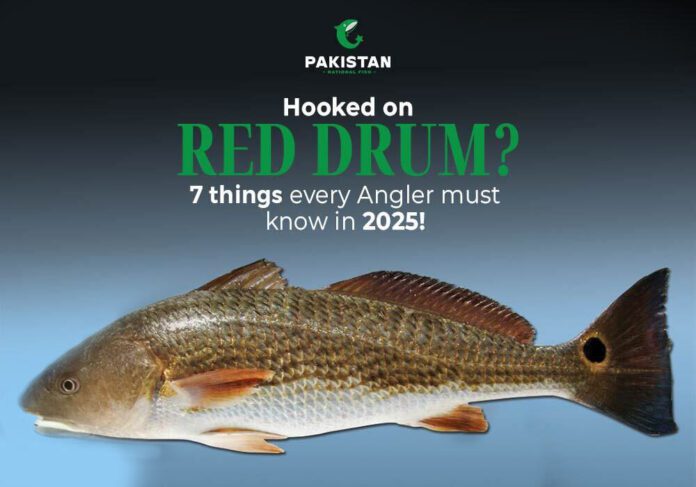This large, elongated nearshore fish—known for the distinctive black eye spot near its tail—ranges in color from deep copper to pale silver. The red drum fish thrives in diverse habitats, from surf zones and seagrass beds to river mouths and estuaries, thanks to its high tolerance for fluctuations in water temperature and salinity. Its name comes from the drumming or croaking sound produced by its abdominal muscles vibrating against the swim bladder. Averaging around 40 inches in length, the red drum is a favorite both in public aquariums and among recreational anglers. Much like the prized Japanese Yellowtail Amberjack, which is known for its strength and sleek body, the red drum is also valued as a delicious catch in culinary circles, making it a sought-after species on both coasts.
Table of Contents
1. What Is a Red Drum Fish and Why Anglers Are Obsessed?
Feature | Description |
Common Name | Red Drum / Redfish |
Scientific Name | Sciaenops ocellatus |
Habitat | Saltwater (Coastal), Brackish, Some Freshwater |
Weight Range | 5–30+ lbs (Trophy-sized can exceed 50 lbs) |
Lifespan | Up to 40 years |
Known For | Spot on tail, copper hue, powerful runs |
2. What Does a Red Drum Fish Look Like?
This isn’t your average backyard pond fish. Red drum fish are built for both speed and strength.
- Color: Burnished bronze to reddish-gold
- Body: Long, streamlined
- Signature Trait: Large black spot near the tail (sometimes multiple)
- Scales: Tough, metallic-like
- Head: Blunt with downward-pointing mouth – perfect for bottom feeding
3. What’s the Difference Between Kinds of Red Fish?
Common Name | Scientific Name | Key Differences |
Red Drum | Sciaenops ocellatus | Classic redfish, copper body, black tail spot |
Red Snapper | Lutjanus campechanus | Deep-sea dweller, more vibrant red, firm meat |
Rose Fish | Sebastes norvegicus | Found in colder waters, smaller body |
Vermilion Snapper | Rhomboplites aurorubens | Slimmer than red snapper, mild taste |
4. Where and When Is the Redfish Season in Florida?
Region | Season | Notes |
Gulf Coast | Year-round | Best in fall (Sept–Nov) |
Atlantic Coast | Year-round | Peak in spring & fall |
- Legal Limit (Florida):
- Slot Size: 18–27 inches
- Bag Limit: 1 fish per person/day
- No harvest in some conservation zones
Always check the Florida Fish and Wildlife Commission site before heading out!
5. What Is the Red Drum Diet?
Food Type | Examples |
Crustaceans | Shrimp, blue crabs, fiddler crabs |
Baitfish | Mullet, menhaden, pinfish |
Mollusks | Clams, oysters |
Others | Worms, small squid |
Best Bait for Red Drum:
- Live shrimp
- Cut mullet
- Soft plastic lures (gold or white)
- Topwater plugs (morning bite)
6. Can You Catch Red Drum in Freshwater?
Yes—but with a twist.
- Freshwater Red Drum: Some are stocked in inland lakes (not native).
- States like Texas and Oklahoma have freshwater populations in warm, man-made reservoirs.
- Differences:
- Tend to grow faster
- Taste may vary due to different diet
Interesting Fact: Red drum require brackish water to spawn, so freshwater fish are often hatchery-raised.
7. Is Redfish Good to Eat or Just Fun to Catch?
Feature | Description |
Flavor | Mild, sweet, less “fishy” |
Texture | Firm, flaky |
Popular Recipes | Blackened redfish, grilled fillets |
Mercury Level | Low-moderate (safe for moderate eating) |
How to Catch Redfish Like a Pro in 2025?
Want to hook a trophy? Here’s your 2025 pro fishing checklist:
Gear
- Rod: Medium-heavy spinning rod (7′ or more)
- Reel: 2500–4000 series
- Line: 10–20 lb braided, with 20–30 lb fluorocarbon leader
Locations
- Grass flats
- Mangroves
- Estuaries
- Inlets and coastal marshes
Best Time
- Dawn and dusk (low-light = higher bites)
- Incoming tide (brings bait in)
What Are the Best Types of Red Fish to Eat?
Red Fish Type | Taste Rating | Best Cooking Method |
Red Drum | ★★★★☆ | Grilled, blackened |
Red Snapper | ★★★★★ | Baked, fried, ceviche |
Vermilion Snapper | ★★★★☆ | Sautéed, pan-seared |
FAQs: Red Drum Fish Answered
Final Thoughts: Cast the Line or Let It Swim?
The red drum fish in Florida is more than just a catch—it’s a tradition. Whether you’re savoring a grilled filet, battling one in shallow waters, or planning your trip around the redfish season Florida, the experience is unforgettable.
Final Tips:
- Check local size limits before keeping your catch
- Practice catch and release for large breeders
- Explore both saltwater and freshwater red drum spots


